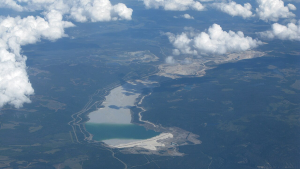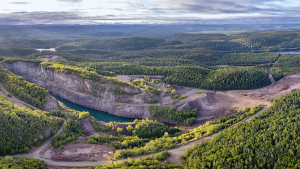A quick succession of explosions on a quiet Sunday morning was all it took to reduce an entire section of stands in a football stadium to about 5,000 tonnes of broken concrete rubble.
OTTAWA
A quick succession of explosions on a quiet Sunday morning was all it took to reduce an entire section of stands in a football stadium to about 5,000 tonnes of broken concrete rubble.
The entire lower section of the south-side stands at Frank Clair Stadium was brought down by 228 carefully timed blasts that started in one corner of the section, rumbled east to west, column to column. A cloud of dust rose and drifted away on an east wind, leaving the upper section of stands intact behind an elongated pile of trash.
The operation went so smoothly that a banner reading “Tomlinson” hanging from the upper stand façade scarcely fluttered.
R. W. Tomlinson Ltd. is the contractor on the demolition and removal contract, although Dykon Blasting Corp., of Tulsa, Okla., did the actual explosive work as a subcontractor.
According to Dale Harley, media spokesperson for R. W. Tomlinson Ltd., the event was very much a controlled blast.
“This is the first implosion that has taken place in Ottawa,” says Harley. “We actually brought a contractor up from Oklahoma to provide us with some technical assistance on the actual blast.”
R. W. Tomlinson has a great deal of experience in blasting in both quarry and a road-building settings, but this was their first involvement with a structure.
Chris Kollar, project manager for R. W. Tomlinson, says that being involved in the project was something he will remember.
“It’s the first time we’ve done a structure,” says Kollar. “It was awfully exciting. It’s been a heck of a week.”
“We’re happy, the city’s happy. It’s down on the ground, right where it’s supposed to be. It’s all good.”
Work will begin almost immediately to remove the 4,500 tonnes of debris from the site with virtually everything being recycled.
“We’re going to go in there and start crunching up that concrete,” says Kollar. “All the scrap metal will be collected and sent to the scrap metal dealer and the concrete we’re going to haul to our quarries where we are going to blend it into the road granular. Everything you see on the ground is going to be 100 per cent recycled.”
The lower stands, accommodating 6,648 seats representing roughly a quarter of the stadium’s capacity, were built in 1961.
Cracking in the supporting columns was detected during a recent inspection, and repair would have been so costly that city council decided to take the stands down, instead.
The upper stands, built about 15 years later, are a separate structure, and are still sound .
The city says they are “are considered to be safe and in reasonable condition for their age and design.”
Tomlinson operates a recycling facility for construction and demolition waste, and is expected to divert well over 90 per cent of Sunday’s rubble into recycling programs. A lot of the concrete will be crushed into granular for use in roadbuilding.
During the weeks before the demolition, benches were removed from the stands, concession stands and boxes were dismantled and the first few rows of seats taken away. What remained to deal with Sunday was just the concrete.
Dykon had been on the site days before Sunday morning’s “shoot,” drilling holes in 38 of the 57 supporting columns to accommodate explosive charges, then wrapping the columns in several layers of fabric, then chain link mesh, in order to prevent flying debris.
Still, pedestrian and vehicular traffic was blocked off and foot and boat traffic on the adjacent Rideau Canal was also banned for a couple of hours. The airspace over the stadium was also closed to aircraft.
If there is any such thing as a “gentle” explosion, this was it. As the columns were blasted in sequence along the stands, the structure seemed to hover for a moment in mid-air, then slumped forward toward the stadium’s playing surface.
Kollar was obviously elated when he spoke with the news media after the blasts.
The stands came down “nice and gracefully,” he said. And, despite the proximity to the upper stands, there was no apparent damage to them.
“There are a couple of drain pipes that have to be re-attached, and that’s about it,” he said.
No one yet knows what will become of the rest of the stadium once the site is cleaned up.
The stadium is the centerpiece of Lansdowne Park, a 40-acre, city-owned property south of the city’s downtown core.
City council has talked from time to time of redeveloping the site, and the discovery of the cracks in the lower stands has made some sort of decision imperative.
A local group has been granted a conditional franchise in the Canadian Football League, but one of the conditions is having an adequate stadium.
At the moment, no one knows what the franchise group might expect of the city, or even whether the demolished stands will be rebuilt and the rest of the stadium refurbished for a new team.










Recent Comments
comments for this post are closed